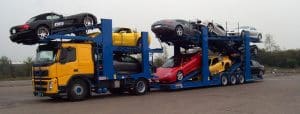If you are looking to buy a hybrid or electric car and get it shipped to you, or you have to move one because of corporate relocation, retirement, extended leave, or another reason, keep reading for details about this evolving industry, battery regulations, and concerns regarding shipping hybrids and electric cars. Just like with any car, truck, motorcycle, quad, or Jet Ski, delivering your hybrid or electric car safely requires expertise from a reputable car mover. Safely shipping an electric or hybrid car requires the experience of a skilled car mover, as does shipping any of the vehicles mentioned above. Electric and hybrid cars need to be transported safely in order to prevent the batteries from moving around and shorting out.
When shipping an electric or hybrid vehicle, it is important to keep in mind that these vehicles are heavier and need some special attention. The main difference when shipping an electric vehicle is related to the batteries. Lithium-ion batteries are heavier, and car transportation rates factor the vehicles weight. Aside from lithium-ion batteries, the regulations for shipping an electric car are similar to those for conventional cars.
Because of larger batteries and increased weight, many car haulers will charge more for transporting a hybrid or electric car. Electric vehicles use larger batteries to provide energy, which can add a pretty significant amount of weight to the total weight of the electric or hybrid car. Battery-electric cars can weigh a lot more because of the massive size and weight of their batteries.
Batteries in electric cars are typically designed to last for the vehicles expected lifespan. Like the engines in regular vehicles, advanced batteries in plug-in electric vehicles (PEVs) are designed to have long lifespans, but they eventually deplete. A plug-in hybrid operates in a similar manner to an electric car, as its gasoline engine is essentially idle while the battery is charged.
Plug-in hybrid electric vehicles (PHEVs) are a mix of gasoline-electric vehicles, thus having a battery, an electric motor, a gas tank, and a internal combustion engine. Other PHEVs – sometimes called blended-mode PHEVs – combine gasoline and electric energy together to provide power for the car, as long as the battery is charged. You charge a big, pulling battery by connecting it to an electric outlet, or charging an appliance called an electric vehicle supply equipment (EVSE).
A hybrid car switches smoothly between electrical energy and a gasoline-electric hybrid, while an electric car runs solely on the power from the battery. While charging a battery can add to power plant pollution, overall emissions associated with driving electric vehicles are typically lower than gasoline cars – especially if power is generated by renewable sources such as wind. The additional materials and energy involved in making the lithium-ion battery means that, currently, the carbon emissions associated with making an electric vehicle are higher than the emissions of vehicles running on gas or diesel — up to 38%, according to some calculations.
The production of any vehicle, electric or otherwise, produces carbon emissions, whether it is the coal used to smelt the steel used to make any cars bodywork, or the diesel used in shipping its electronics components over the seas. While hybrids and electric engines, as well as the cars batteries, are built with the vehicles own materials, manufacturers have taken some steps to mitigate this risk.
The electric systems (battery, motor, and associated electronics) typically need little scheduled maintenance, and brake systems typically last longer than conventional vehicles due to regenerative braking. Carrier companies should secure EVs and hybrids securely, preventing any over-reaching and short-circuiting of the batteries during transportation. As long as the electric vehicle is not charging in transit, and all electric systems are completely shut off, the number of boxes to check is much lower in shipping containers.
Transporting an EV requires finding a transporter that has experience moving electric vehicles, along with equipment and an understanding of the delicate components that are in every car that they are handling. There is a lot of misinformation out in the field in regards to transportation of hybrids and electric cars and trucks, because the types of vehicles are still relatively new. While the up-front costs for buying HEVs and electric trucks are still high, emerging data indicates hybrids and electric vehicles can save drivers money over the long term.
While sales of all-electric cars and plug-in hybrids now make up less than 2% of light-vehicle sales in the United States, interest among auto buyers has been growing. According to Bloombergs forecast, EVs will make up 58 percent of global car sales by 2040. Toyota, Volkswagen, and Tesla, the big three auto brands, introduced electric vehicles into the market to meet the consumer demand for a more convenient, more eco-friendly form of transportation. Over the past decade, various pro-electric car (EV) policies have been implemented in major markets, helping stimulate the significant expansion of electric vehicle models.
Countries currently fielding a limited number of EVs could benefit from lessons learned and advances already made in vehicle and battery technologies in order to support EV production and adoption. In the longer run, realizing EVs full potential for contributing to reductions in auto emissions requires integration of EVs into electricity systems, the decarbonization of electricity generation, deployment of charging infrastructure, and production of sustainable batteries. For electric vehicles to realize their full potential in climate action, the 2020s must be a decade of widespread deployment of light-duty EVs.
Taking full advantage of taking good care of your EV or hybrid during your commute will increase its value in the long run. If you are an electric or hybrid car owner, this has been a substantial investment.
Until electricity in national grids is completely renewable, charging batteries will have involved some level of dependence on coal-fired or natural-gas-fired plants. Hybrids and all-electric cars are great news for consumers, cheaper to operate than fossil-fuel powered cars, and good news for urban planners struggling to contain urban centers air pollution.








